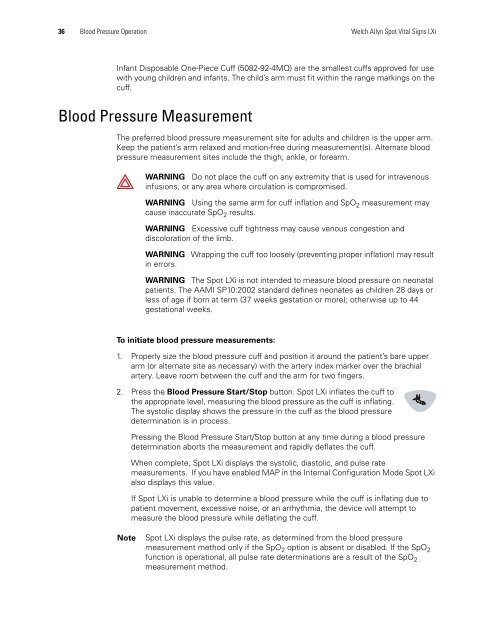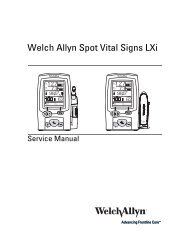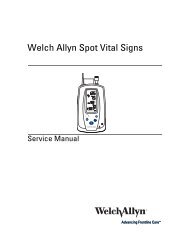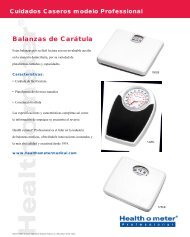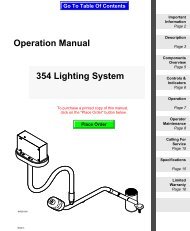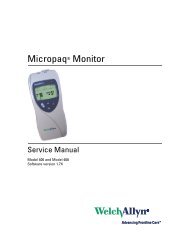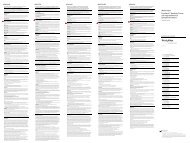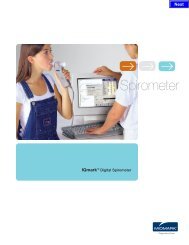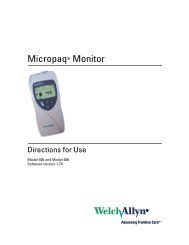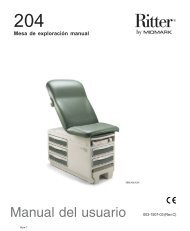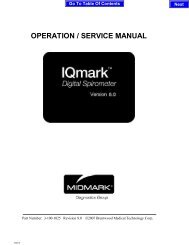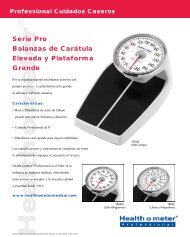Spot Vital Signs LXi Directions for Use - Frank's Hospital Workshop
Spot Vital Signs LXi Directions for Use - Frank's Hospital Workshop
Spot Vital Signs LXi Directions for Use - Frank's Hospital Workshop
You also want an ePaper? Increase the reach of your titles
YUMPU automatically turns print PDFs into web optimized ePapers that Google loves.
36 Blood Pressure Operation Welch Allyn <strong>Spot</strong> <strong>Vital</strong> <strong>Signs</strong> <strong>LXi</strong><br />
Infant Disposable One-Piece Cuff (5082-92-4MQ) are the smallest cuffs approved <strong>for</strong> use<br />
with young children and infants. The child’s arm must fit within the range markings on the<br />
cuff.<br />
Blood Pressure Measurement<br />
The preferred blood pressure measurement site <strong>for</strong> adults and children is the upper arm.<br />
Keep the patient’s arm relaxed and motion-free during measurement(s). Alternate blood<br />
pressure measurement sites include the thigh, ankle, or <strong>for</strong>earm.<br />
WARNING Do not place the cuff on any extremity that is used <strong>for</strong> intravenous<br />
infusions, or any area where circulation is compromised.<br />
WARNING Using the same arm <strong>for</strong> cuff inflation and SpO 2 measurement may<br />
cause inaccurate SpO 2 results.<br />
WARNING Excessive cuff tightness may cause venous congestion and<br />
discoloration of the limb.<br />
WARNING Wrapping the cuff too loosely (preventing proper inflation) may result<br />
in errors.<br />
WARNING The <strong>Spot</strong> <strong>LXi</strong> is not intended to measure blood pressure on neonatal<br />
patients. The AAMI SP10:2002 standard defines neonates as children 28 days or<br />
less of age if born at term (37 weeks gestation or more); otherwise up to 44<br />
gestational weeks.<br />
To initiate blood pressure measurements:<br />
1. Properly size the blood pressure cuff and position it around the patient’s bare upper<br />
arm (or alternate site as necessary) with the artery index marker over the brachial<br />
artery. Leave room between the cuff and the arm <strong>for</strong> two fingers.<br />
2. Press the Blood Pressure Start/Stop button. <strong>Spot</strong> <strong>LXi</strong> inflates the cuff to<br />
the appropriate level, measuring the blood pressure as the cuff is inflating.<br />
The systolic display shows the pressure in the cuff as the blood pressure<br />
determination is in process.<br />
Pressing the Blood Pressure Start/Stop button at any time during a blood pressure<br />
determination aborts the measurement and rapidly deflates the cuff.<br />
When complete, <strong>Spot</strong> <strong>LXi</strong> displays the systolic, diastolic, and pulse rate<br />
measurements. If you have enabled MAP in the Internal Configuration Mode <strong>Spot</strong> <strong>LXi</strong><br />
also displays this value.<br />
If <strong>Spot</strong> <strong>LXi</strong> is unable to determine a blood pressure while the cuff is inflating due to<br />
patient movement, excessive noise, or an arrhythmia, the device will attempt to<br />
measure the blood pressure while deflating the cuff.<br />
Note <strong>Spot</strong> <strong>LXi</strong> displays the pulse rate, as determined from the blood pressure<br />
measurement method only if the SpO 2 option is absent or disabled. If the SpO 2<br />
function is operational, all pulse rate determinations are a result of the SpO 2<br />
measurement method.


